Importance of Effective Communication in Culturally Safe Healthcare
VerifiedAdded on 2020/04/01
|9
|1305
|91
Presentation
AI Summary
This assignment presents a comprehensive overview of effective communication within a culturally safe healthcare setting. The presentation, designed for new staff orientation, emphasizes the significance of clear, concise communication and its impact on patient care and satisfaction. It explores the communication process, highlighting the roles of senders and recipients, and addresses common barriers such as jargon, cultural differences, and physical disabilities. The document introduces strategies to reduce communication noise, improve patient understanding, and foster a more compassionate healthcare environment. It underscores the importance of providing sufficient information, utilizing various communication tools, and obtaining patient feedback. Additionally, it incorporates practical examples, like the 'AWARE' acronym, and discusses the positive effects of effective communication on patient outcomes, team relationships, and overall safety. The assignment concludes by emphasizing communication's pivotal role in enhancing patient well-being and satisfaction in healthcare.
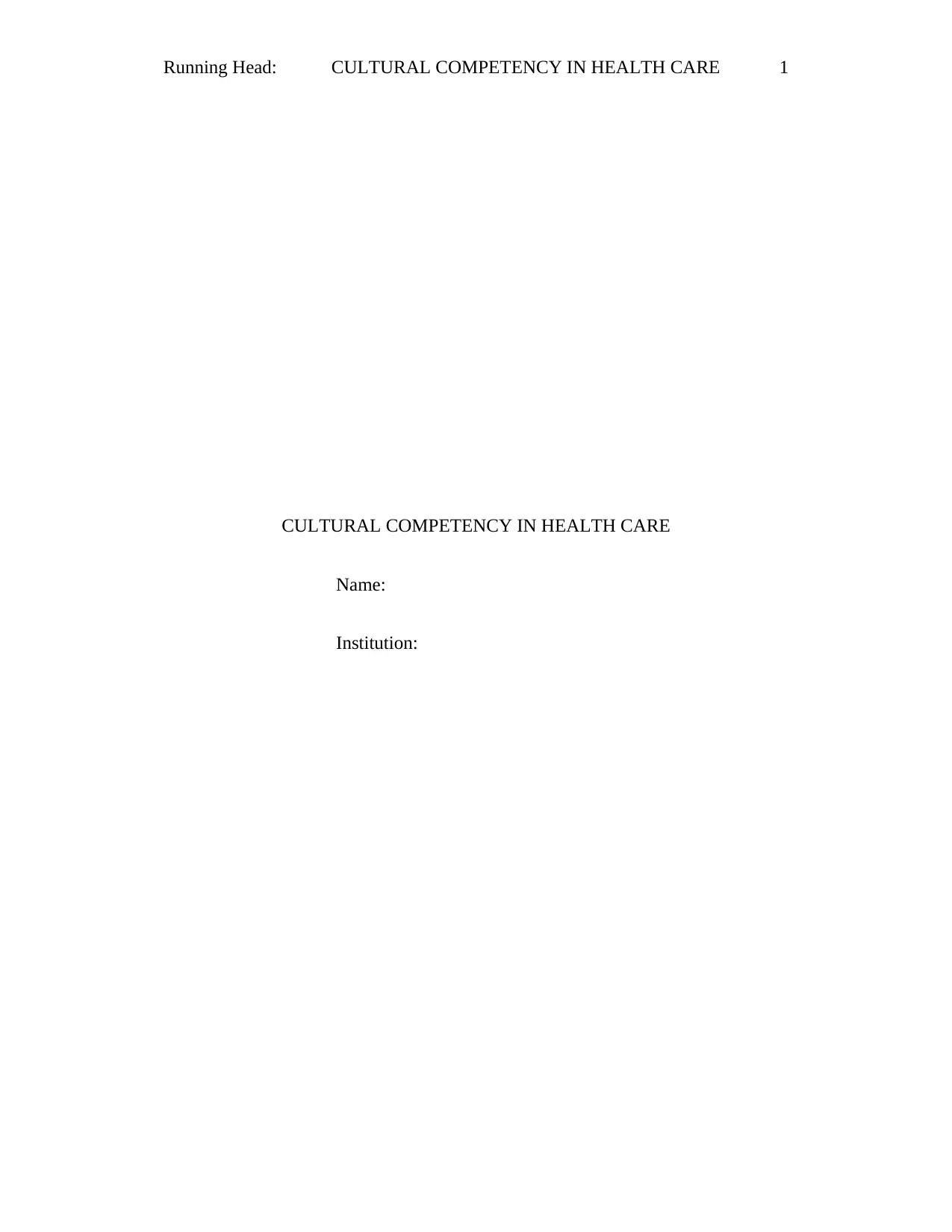
Running Head: CULTURAL COMPETENCY IN HEALTH CARE 1
CULTURAL COMPETENCY IN HEALTH CARE
Name:
Institution:
CULTURAL COMPETENCY IN HEALTH CARE
Name:
Institution:
Paraphrase This Document
Need a fresh take? Get an instant paraphrase of this document with our AI Paraphraser
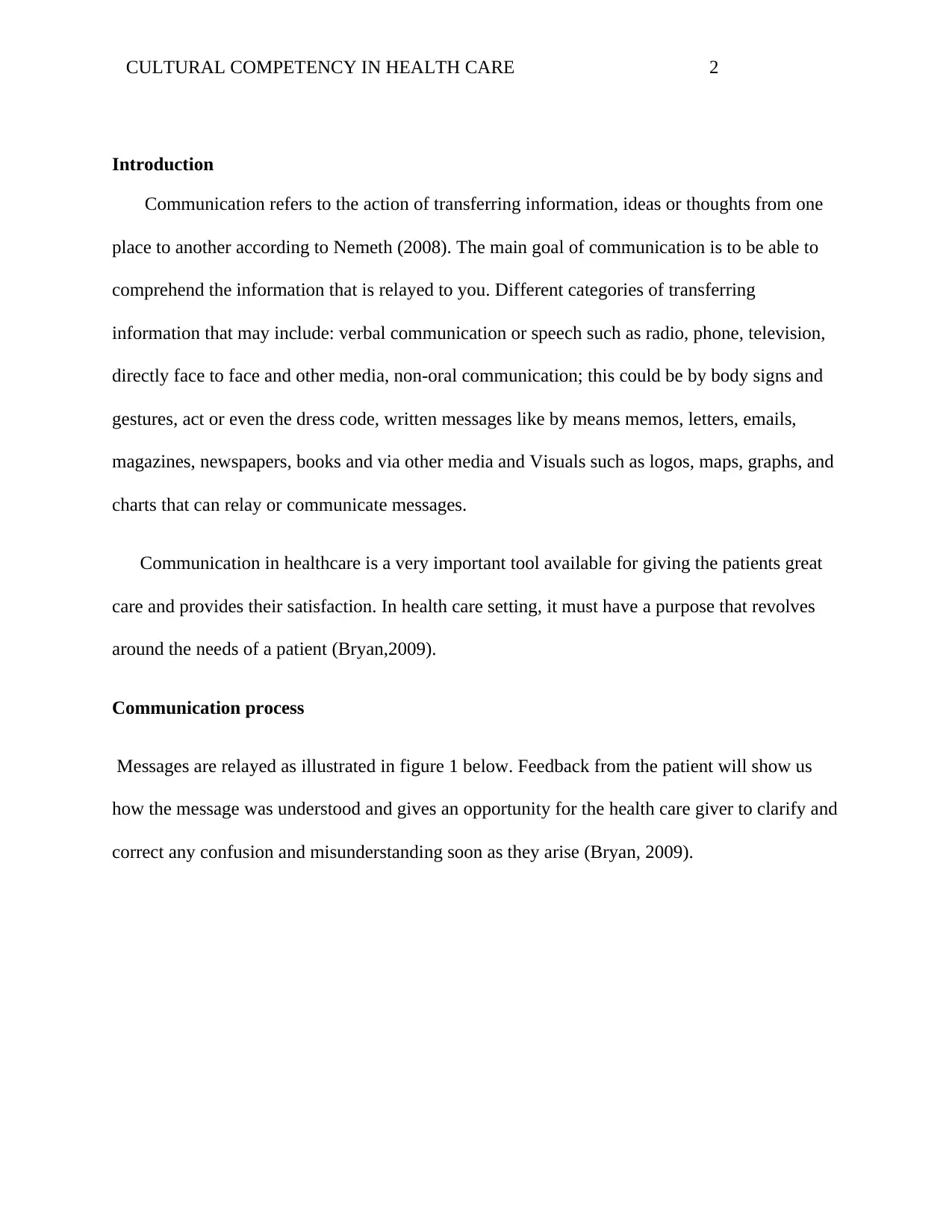
CULTURAL COMPETENCY IN HEALTH CARE 2
Introduction
Communication refers to the action of transferring information, ideas or thoughts from one
place to another according to Nemeth (2008). The main goal of communication is to be able to
comprehend the information that is relayed to you. Different categories of transferring
information that may include: verbal communication or speech such as radio, phone, television,
directly face to face and other media, non-oral communication; this could be by body signs and
gestures, act or even the dress code, written messages like by means memos, letters, emails,
magazines, newspapers, books and via other media and Visuals such as logos, maps, graphs, and
charts that can relay or communicate messages.
Communication in healthcare is a very important tool available for giving the patients great
care and provides their satisfaction. In health care setting, it must have a purpose that revolves
around the needs of a patient (Bryan,2009).
Communication process
Messages are relayed as illustrated in figure 1 below. Feedback from the patient will show us
how the message was understood and gives an opportunity for the health care giver to clarify and
correct any confusion and misunderstanding soon as they arise (Bryan, 2009).
Introduction
Communication refers to the action of transferring information, ideas or thoughts from one
place to another according to Nemeth (2008). The main goal of communication is to be able to
comprehend the information that is relayed to you. Different categories of transferring
information that may include: verbal communication or speech such as radio, phone, television,
directly face to face and other media, non-oral communication; this could be by body signs and
gestures, act or even the dress code, written messages like by means memos, letters, emails,
magazines, newspapers, books and via other media and Visuals such as logos, maps, graphs, and
charts that can relay or communicate messages.
Communication in healthcare is a very important tool available for giving the patients great
care and provides their satisfaction. In health care setting, it must have a purpose that revolves
around the needs of a patient (Bryan,2009).
Communication process
Messages are relayed as illustrated in figure 1 below. Feedback from the patient will show us
how the message was understood and gives an opportunity for the health care giver to clarify and
correct any confusion and misunderstanding soon as they arise (Bryan, 2009).
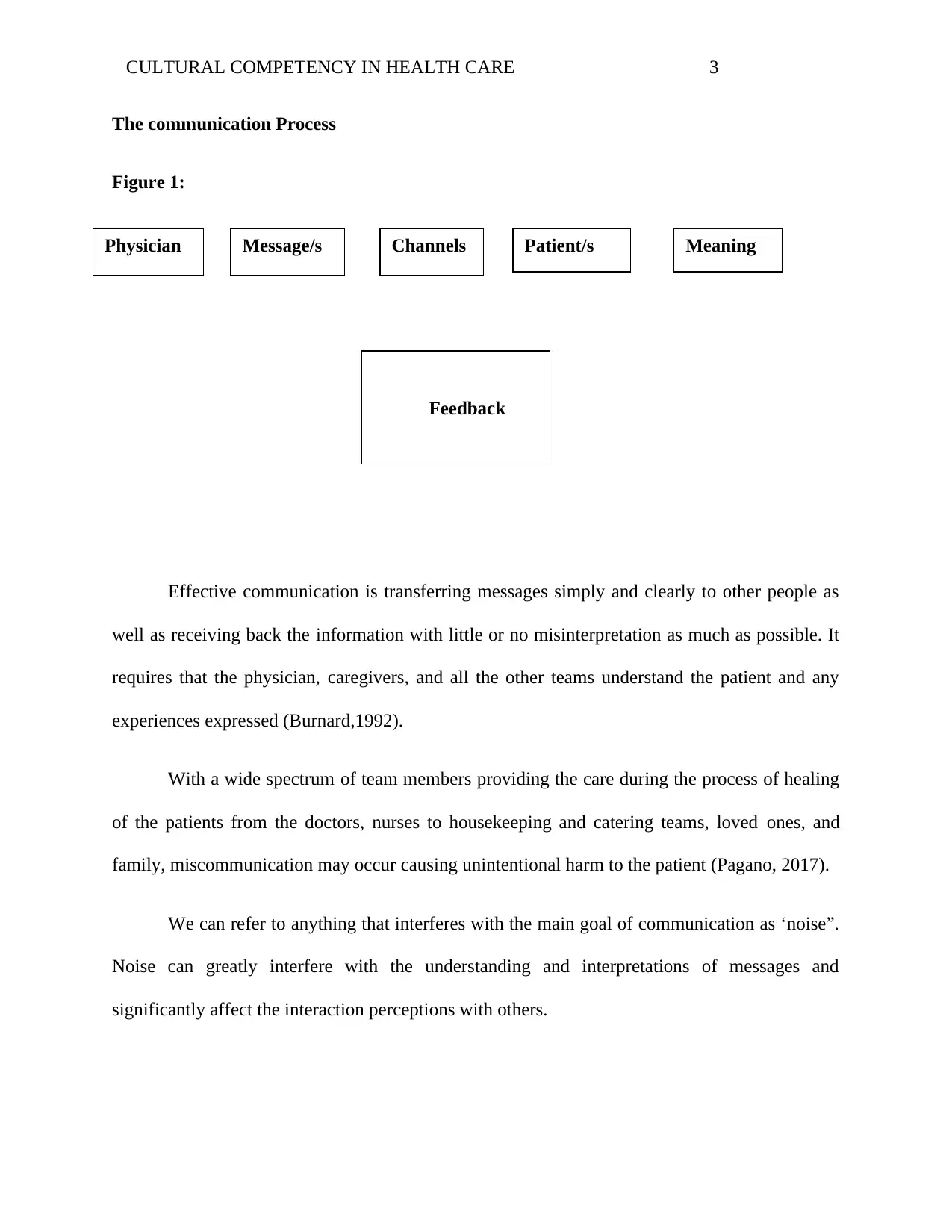
CULTURAL COMPETENCY IN HEALTH CARE 3
The communication Process
Figure 1:
Effective communication is transferring messages simply and clearly to other people as
well as receiving back the information with little or no misinterpretation as much as possible. It
requires that the physician, caregivers, and all the other teams understand the patient and any
experiences expressed (Burnard,1992).
With a wide spectrum of team members providing the care during the process of healing
of the patients from the doctors, nurses to housekeeping and catering teams, loved ones, and
family, miscommunication may occur causing unintentional harm to the patient (Pagano, 2017).
We can refer to anything that interferes with the main goal of communication as ‘noise”.
Noise can greatly interfere with the understanding and interpretations of messages and
significantly affect the interaction perceptions with others.
Physician Message/s Channels Patient/s Meaning
Feedback
The communication Process
Figure 1:
Effective communication is transferring messages simply and clearly to other people as
well as receiving back the information with little or no misinterpretation as much as possible. It
requires that the physician, caregivers, and all the other teams understand the patient and any
experiences expressed (Burnard,1992).
With a wide spectrum of team members providing the care during the process of healing
of the patients from the doctors, nurses to housekeeping and catering teams, loved ones, and
family, miscommunication may occur causing unintentional harm to the patient (Pagano, 2017).
We can refer to anything that interferes with the main goal of communication as ‘noise”.
Noise can greatly interfere with the understanding and interpretations of messages and
significantly affect the interaction perceptions with others.
Physician Message/s Channels Patient/s Meaning
Feedback
⊘ This is a preview!⊘
Do you want full access?
Subscribe today to unlock all pages.

Trusted by 1+ million students worldwide
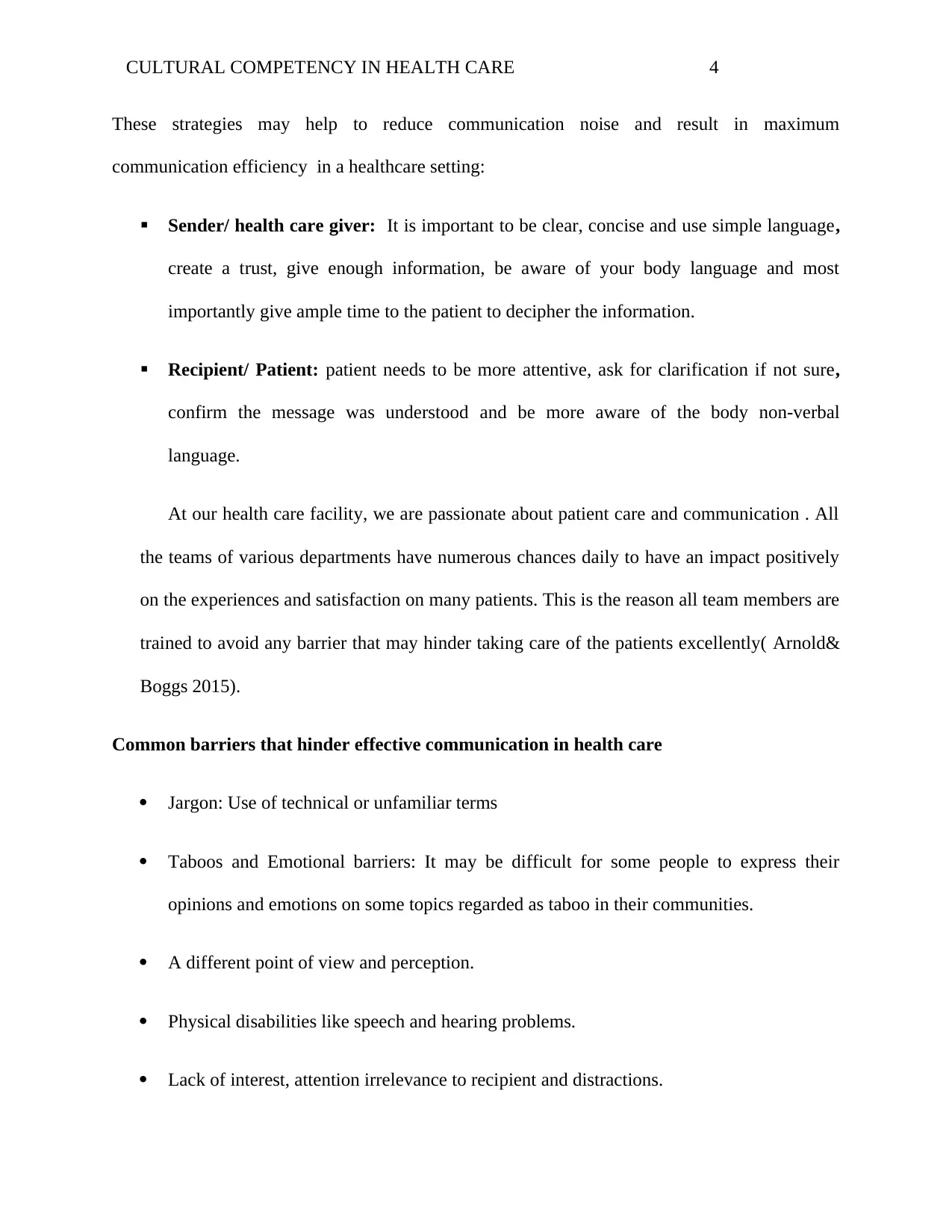
CULTURAL COMPETENCY IN HEALTH CARE 4
These strategies may help to reduce communication noise and result in maximum
communication efficiency in a healthcare setting:
Sender/ health care giver: It is important to be clear, concise and use simple language,
create a trust, give enough information, be aware of your body language and most
importantly give ample time to the patient to decipher the information.
Recipient/ Patient: patient needs to be more attentive, ask for clarification if not sure,
confirm the message was understood and be more aware of the body non-verbal
language.
At our health care facility, we are passionate about patient care and communication . All
the teams of various departments have numerous chances daily to have an impact positively
on the experiences and satisfaction on many patients. This is the reason all team members are
trained to avoid any barrier that may hinder taking care of the patients excellently( Arnold&
Boggs 2015).
Common barriers that hinder effective communication in health care
Jargon: Use of technical or unfamiliar terms
Taboos and Emotional barriers: It may be difficult for some people to express their
opinions and emotions on some topics regarded as taboo in their communities.
A different point of view and perception.
Physical disabilities like speech and hearing problems.
Lack of interest, attention irrelevance to recipient and distractions.
These strategies may help to reduce communication noise and result in maximum
communication efficiency in a healthcare setting:
Sender/ health care giver: It is important to be clear, concise and use simple language,
create a trust, give enough information, be aware of your body language and most
importantly give ample time to the patient to decipher the information.
Recipient/ Patient: patient needs to be more attentive, ask for clarification if not sure,
confirm the message was understood and be more aware of the body non-verbal
language.
At our health care facility, we are passionate about patient care and communication . All
the teams of various departments have numerous chances daily to have an impact positively
on the experiences and satisfaction on many patients. This is the reason all team members are
trained to avoid any barrier that may hinder taking care of the patients excellently( Arnold&
Boggs 2015).
Common barriers that hinder effective communication in health care
Jargon: Use of technical or unfamiliar terms
Taboos and Emotional barriers: It may be difficult for some people to express their
opinions and emotions on some topics regarded as taboo in their communities.
A different point of view and perception.
Physical disabilities like speech and hearing problems.
Lack of interest, attention irrelevance to recipient and distractions.
Paraphrase This Document
Need a fresh take? Get an instant paraphrase of this document with our AI Paraphraser
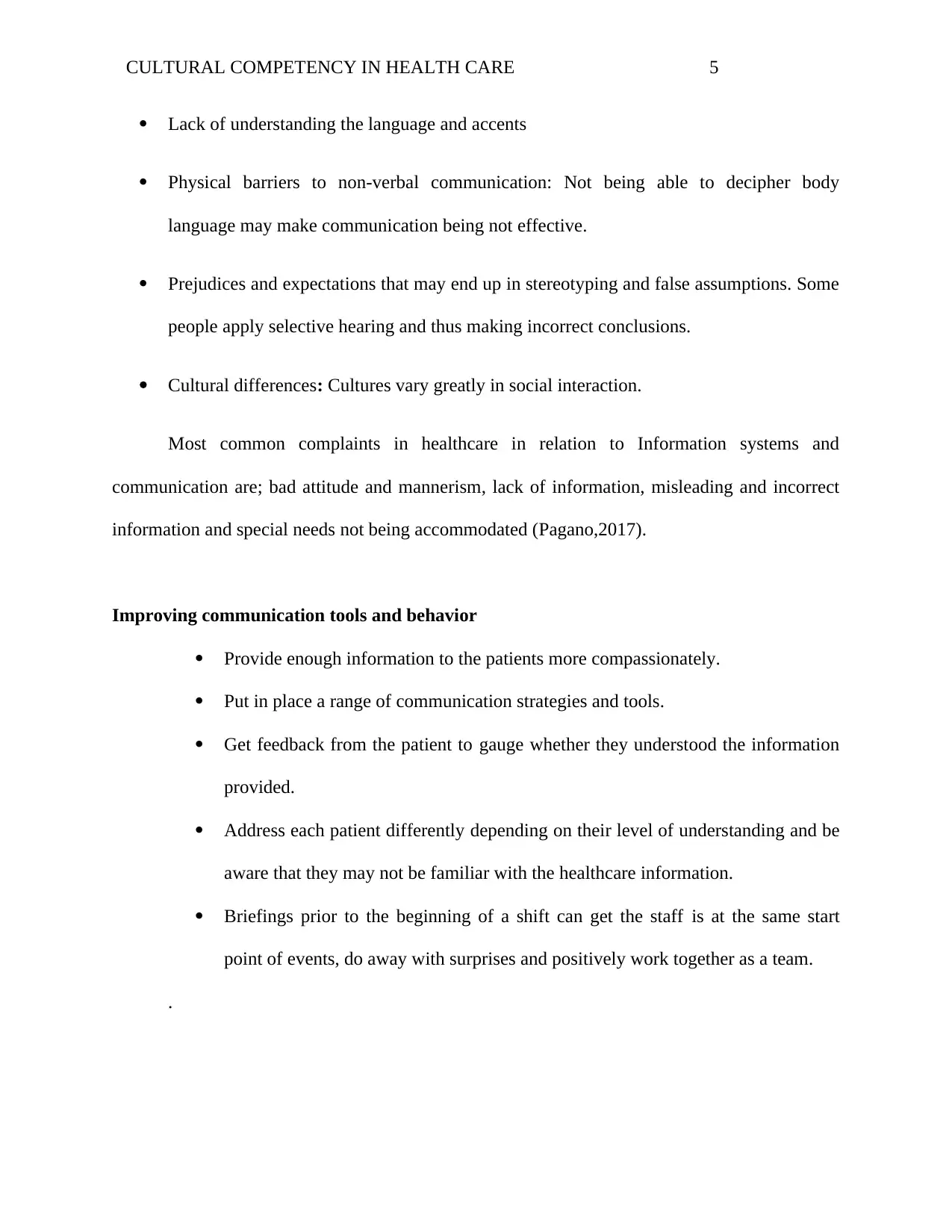
CULTURAL COMPETENCY IN HEALTH CARE 5
Lack of understanding the language and accents
Physical barriers to non-verbal communication: Not being able to decipher body
language may make communication being not effective.
Prejudices and expectations that may end up in stereotyping and false assumptions. Some
people apply selective hearing and thus making incorrect conclusions.
Cultural differences: Cultures vary greatly in social interaction.
Most common complaints in healthcare in relation to Information systems and
communication are; bad attitude and mannerism, lack of information, misleading and incorrect
information and special needs not being accommodated (Pagano,2017).
Improving communication tools and behavior
Provide enough information to the patients more compassionately.
Put in place a range of communication strategies and tools.
Get feedback from the patient to gauge whether they understood the information
provided.
Address each patient differently depending on their level of understanding and be
aware that they may not be familiar with the healthcare information.
Briefings prior to the beginning of a shift can get the staff is at the same start
point of events, do away with surprises and positively work together as a team.
.
Lack of understanding the language and accents
Physical barriers to non-verbal communication: Not being able to decipher body
language may make communication being not effective.
Prejudices and expectations that may end up in stereotyping and false assumptions. Some
people apply selective hearing and thus making incorrect conclusions.
Cultural differences: Cultures vary greatly in social interaction.
Most common complaints in healthcare in relation to Information systems and
communication are; bad attitude and mannerism, lack of information, misleading and incorrect
information and special needs not being accommodated (Pagano,2017).
Improving communication tools and behavior
Provide enough information to the patients more compassionately.
Put in place a range of communication strategies and tools.
Get feedback from the patient to gauge whether they understood the information
provided.
Address each patient differently depending on their level of understanding and be
aware that they may not be familiar with the healthcare information.
Briefings prior to the beginning of a shift can get the staff is at the same start
point of events, do away with surprises and positively work together as a team.
.
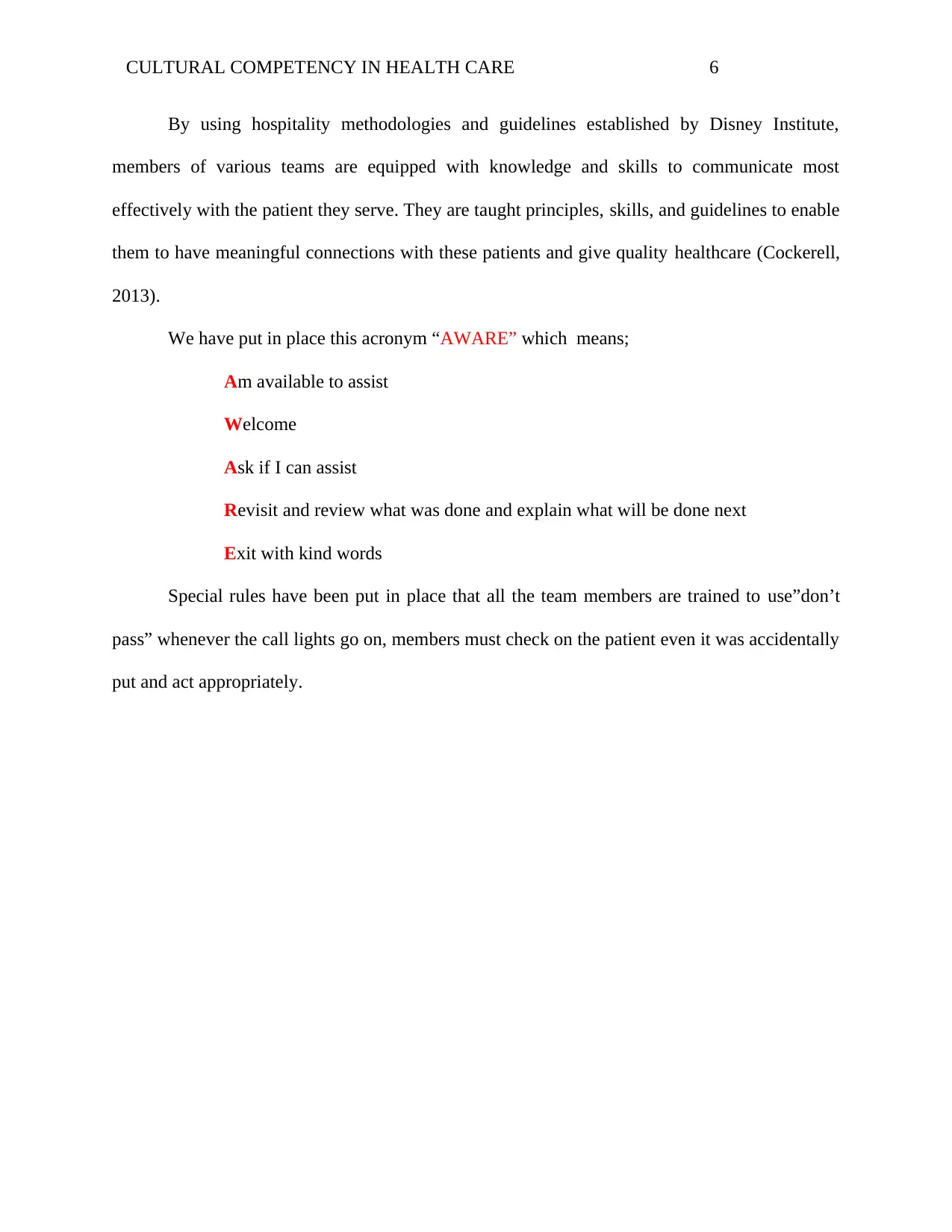
CULTURAL COMPETENCY IN HEALTH CARE 6
By using hospitality methodologies and guidelines established by Disney Institute,
members of various teams are equipped with knowledge and skills to communicate most
effectively with the patient they serve. They are taught principles, skills, and guidelines to enable
them to have meaningful connections with these patients and give quality healthcare (Cockerell,
2013).
We have put in place this acronym “AWARE” which means;
Am available to assist
Welcome
Ask if I can assist
Revisit and review what was done and explain what will be done next
Exit with kind words
Special rules have been put in place that all the team members are trained to use”don’t
pass” whenever the call lights go on, members must check on the patient even it was accidentally
put and act appropriately.
By using hospitality methodologies and guidelines established by Disney Institute,
members of various teams are equipped with knowledge and skills to communicate most
effectively with the patient they serve. They are taught principles, skills, and guidelines to enable
them to have meaningful connections with these patients and give quality healthcare (Cockerell,
2013).
We have put in place this acronym “AWARE” which means;
Am available to assist
Welcome
Ask if I can assist
Revisit and review what was done and explain what will be done next
Exit with kind words
Special rules have been put in place that all the team members are trained to use”don’t
pass” whenever the call lights go on, members must check on the patient even it was accidentally
put and act appropriately.
⊘ This is a preview!⊘
Do you want full access?
Subscribe today to unlock all pages.

Trusted by 1+ million students worldwide
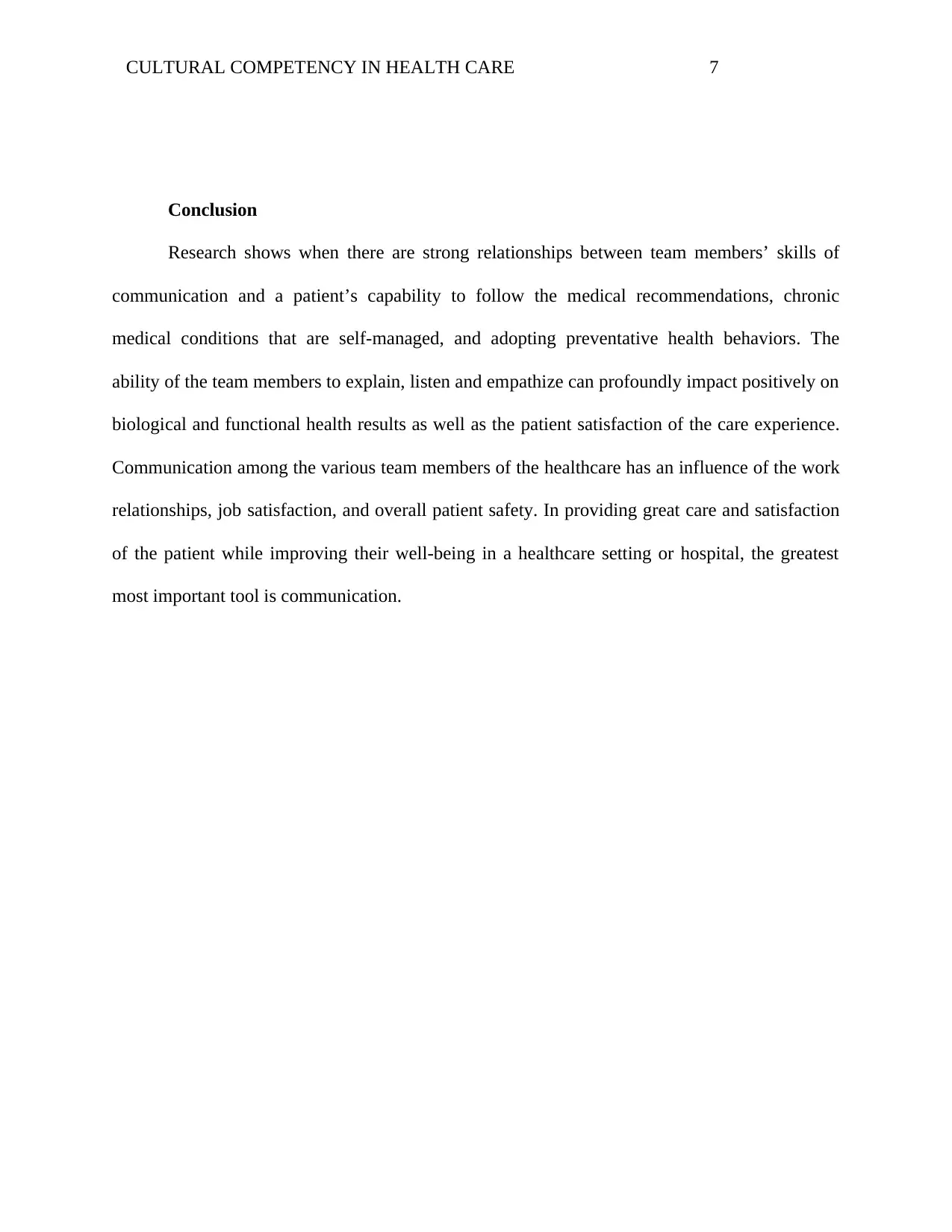
CULTURAL COMPETENCY IN HEALTH CARE 7
Conclusion
Research shows when there are strong relationships between team members’ skills of
communication and a patient’s capability to follow the medical recommendations, chronic
medical conditions that are self-managed, and adopting preventative health behaviors. The
ability of the team members to explain, listen and empathize can profoundly impact positively on
biological and functional health results as well as the patient satisfaction of the care experience.
Communication among the various team members of the healthcare has an influence of the work
relationships, job satisfaction, and overall patient safety. In providing great care and satisfaction
of the patient while improving their well-being in a healthcare setting or hospital, the greatest
most important tool is communication.
Conclusion
Research shows when there are strong relationships between team members’ skills of
communication and a patient’s capability to follow the medical recommendations, chronic
medical conditions that are self-managed, and adopting preventative health behaviors. The
ability of the team members to explain, listen and empathize can profoundly impact positively on
biological and functional health results as well as the patient satisfaction of the care experience.
Communication among the various team members of the healthcare has an influence of the work
relationships, job satisfaction, and overall patient safety. In providing great care and satisfaction
of the patient while improving their well-being in a healthcare setting or hospital, the greatest
most important tool is communication.
Paraphrase This Document
Need a fresh take? Get an instant paraphrase of this document with our AI Paraphraser
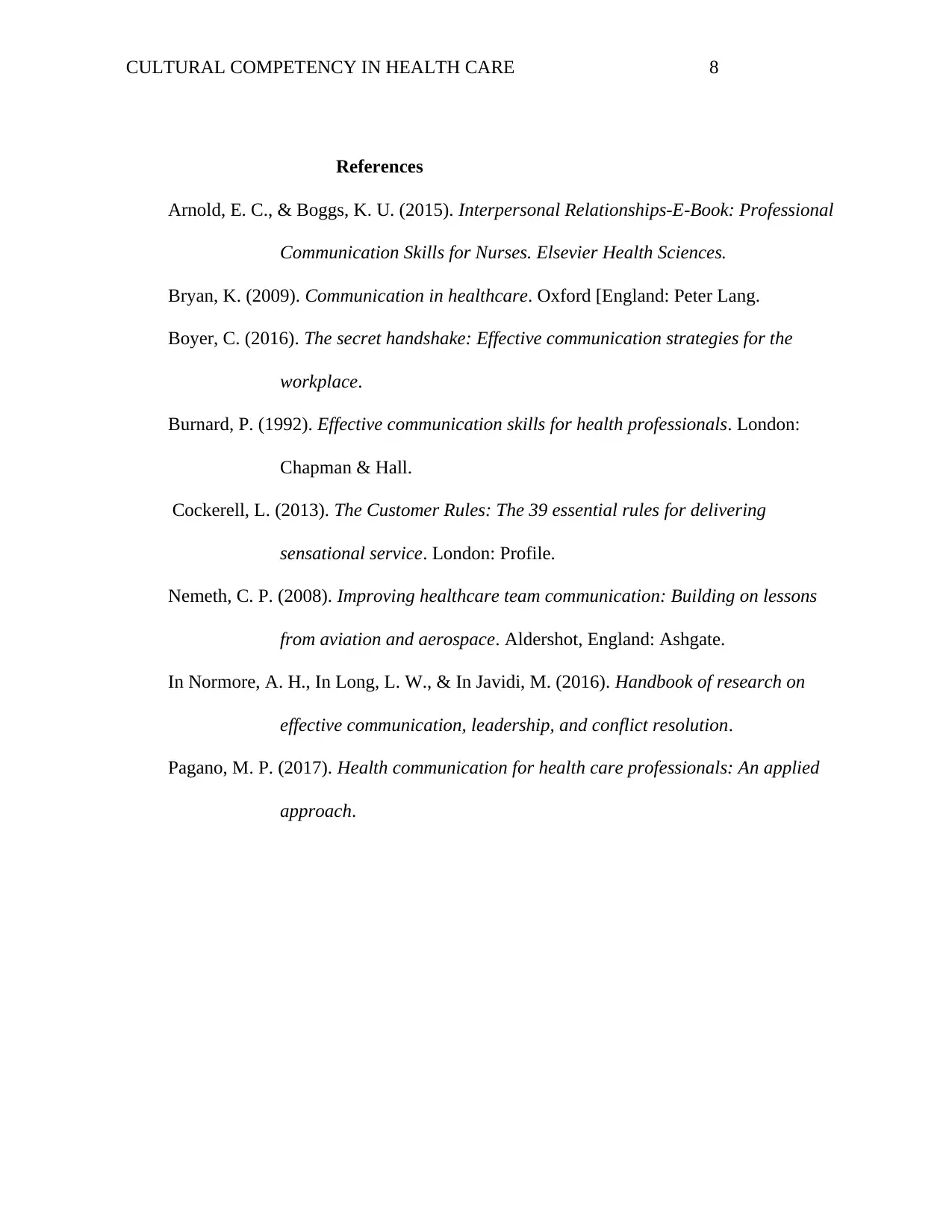
CULTURAL COMPETENCY IN HEALTH CARE 8
References
Arnold, E. C., & Boggs, K. U. (2015). Interpersonal Relationships-E-Book: Professional
Communication Skills for Nurses. Elsevier Health Sciences.
Bryan, K. (2009). Communication in healthcare. Oxford [England: Peter Lang.
Boyer, C. (2016). The secret handshake: Effective communication strategies for the
workplace.
Burnard, P. (1992). Effective communication skills for health professionals. London:
Chapman & Hall.
Cockerell, L. (2013). The Customer Rules: The 39 essential rules for delivering
sensational service. London: Profile.
Nemeth, C. P. (2008). Improving healthcare team communication: Building on lessons
from aviation and aerospace. Aldershot, England: Ashgate.
In Normore, A. H., In Long, L. W., & In Javidi, M. (2016). Handbook of research on
effective communication, leadership, and conflict resolution.
Pagano, M. P. (2017). Health communication for health care professionals: An applied
approach.
References
Arnold, E. C., & Boggs, K. U. (2015). Interpersonal Relationships-E-Book: Professional
Communication Skills for Nurses. Elsevier Health Sciences.
Bryan, K. (2009). Communication in healthcare. Oxford [England: Peter Lang.
Boyer, C. (2016). The secret handshake: Effective communication strategies for the
workplace.
Burnard, P. (1992). Effective communication skills for health professionals. London:
Chapman & Hall.
Cockerell, L. (2013). The Customer Rules: The 39 essential rules for delivering
sensational service. London: Profile.
Nemeth, C. P. (2008). Improving healthcare team communication: Building on lessons
from aviation and aerospace. Aldershot, England: Ashgate.
In Normore, A. H., In Long, L. W., & In Javidi, M. (2016). Handbook of research on
effective communication, leadership, and conflict resolution.
Pagano, M. P. (2017). Health communication for health care professionals: An applied
approach.
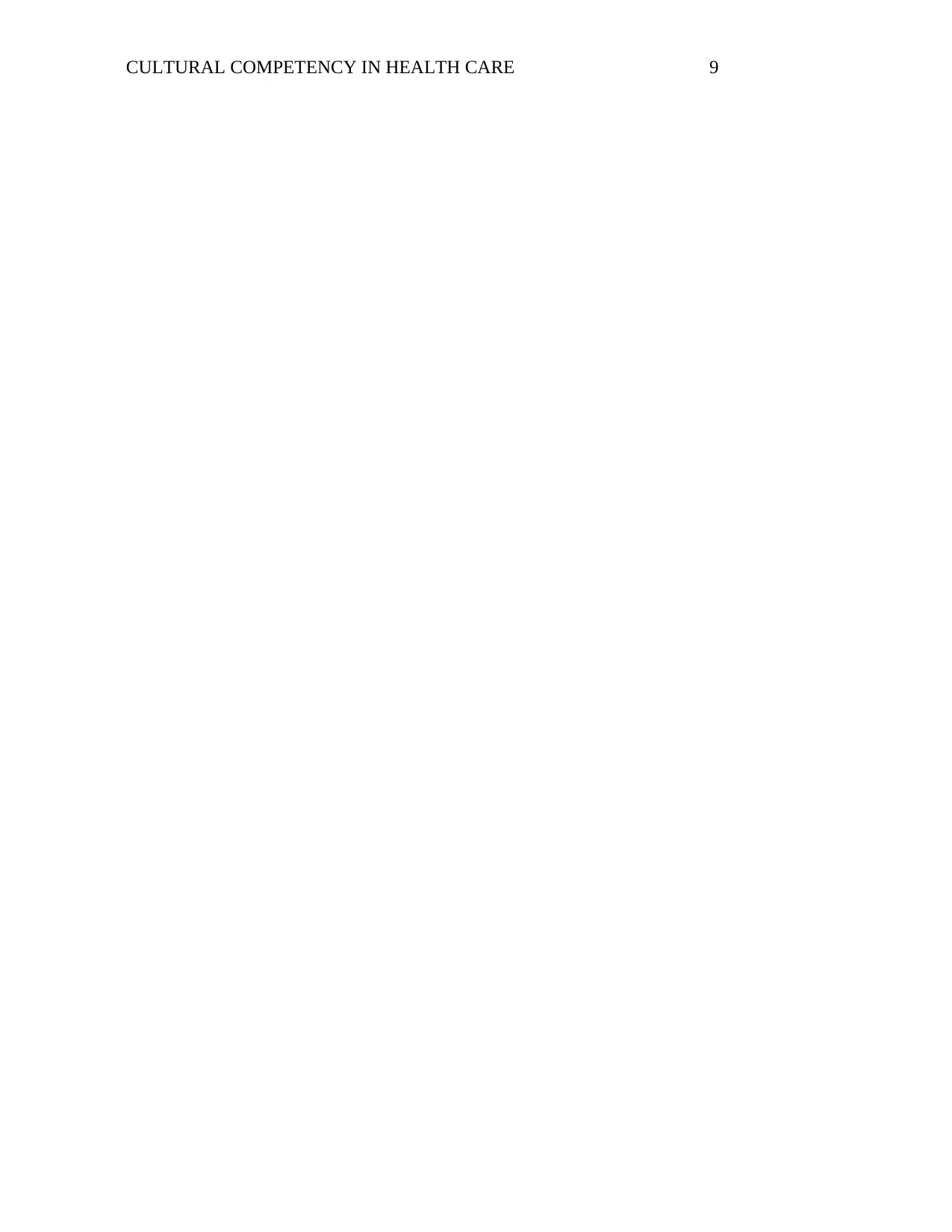
CULTURAL COMPETENCY IN HEALTH CARE 9
⊘ This is a preview!⊘
Do you want full access?
Subscribe today to unlock all pages.

Trusted by 1+ million students worldwide
1 out of 9
Related Documents
Your All-in-One AI-Powered Toolkit for Academic Success.
+13062052269
info@desklib.com
Available 24*7 on WhatsApp / Email
![[object Object]](/_next/static/media/star-bottom.7253800d.svg)
Unlock your academic potential
Copyright © 2020–2025 A2Z Services. All Rights Reserved. Developed and managed by ZUCOL.


